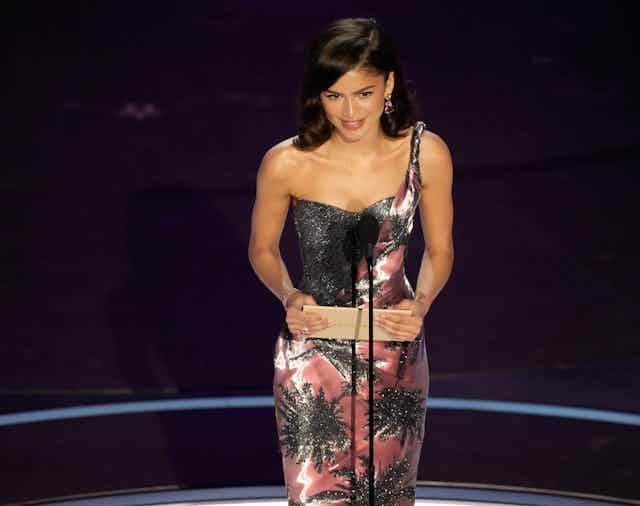Designing an outfit for a celebrity to wear at the Oscars is often seen as a dream opportunity for fashion designers.

Yet, embarking on this journey demands financial investment, brand reputation, creative talent and technical expertise.
Haute couture literally translates as “high dressmaking.” In its strictest sense, this refers to a specific fashion house designation acknowledged by the French Fédération de la Haute Couture et de la Mode. More generally, the term is used to describe the business of creating meticulously crafted garments for an individual client or a special occasion.
Elite haute couture designers have consistently managed to dress celebrities for the Oscars.
Haute couture designers include renowned names like Valentino, Armani Privé, Schiaparelli Couture, Atelier Versace, Christian Dior, Chanel, Givenchy and Saint Laurent. More recently, it’s included Elie Saab, Vivienne Westwood, Giambattista Valli, Prada, Fendi Couture and Vera Wang, among others.
My passion for creativity, design, luxury and fashion has marked my professional career. Previously, I was a researcher at Bocconi University in Milan, Italy, where my work examined made-in-Italy industries and luxury design.
As an Italian who has recently embarked on a new chapter in Canada, I invite you to delve into haute couture with me, where exceptional craftsmanship, innovative designs and strategic expertise come to life.
Distinctive esthetics
Giorgio Armani has described haute couture as “the peak of my world,” highlighting it as a realm where creativity, imagination and the freedom to experiment thrive.
Each haute couture atelier of a particular brand is celebrated for its distinctive esthetic.
Valentino is famed for its glamorous and iconic red evening dresses, while Giorgio Armani Privé is recognized for its attention to detail and elegant attire.

Schiaparelli is known for its avant-garde designs that merge art with fashion.
Fashion and visual art
Haute couture designs can include a range of garments such as gowns, evening wear or wedding attire, all made from premium fabrics.
Skilled artisans devote extraordinary attention to every detail and finish of these garments.
Within each atelier, a hierarchy of craftsmanship exists, ranging from the most experienced “first hands” to “second hands” and then to apprentices, each level reflecting the artisan’s skill and experience.
Each piece remains a symbol

Haute couture showcases a fusion of craftsmanship with cutting-edge design. These pieces are designed to be timeless, crafted with durable materials and components, ensuring each piece remains a lasting symbol of beauty and craftsmanship.
The journey from an initial concept to a completed dress involves several months of craftsmanship, including countless fittings and continuous enhancements to achieve perfection.
The outcome is a work of art distinguished by its intricate textures, a blend of fabrics and materials, elaborate embroidery and exceptional customer service.
Initial design
The design process typically begins with initial sketches, followed by the creation of a muslin or toile prototype, which is then tailored to the desired shape. This stage is crucial for refining the initial ideas into a concept that meets the designer’s vision. For bespoke orders, the designer presents multiple sketches for the client to approve.
The client can select the garment’s silhouette, fabrics, embroidery patterns (if desired) and additional finishing touches. Throughout this process, the client receives guidance from a highly knowledgeable salesperson.
The use of luxurious materials such as silk, tulle, embroidery, lace and feathers, along with innovative combinations of various fabrics, textures and decorative elements, enhances the garment’s elegance and sophistication.
From pattern-making to final masterpiece

For custom-made garments, the creation process starts with customer measurements. A prototype garment is first made from basic fabrics. This step allows for adjustments to ensure the client’s fit and design preferences before the final, more luxurious fabrics are used. For runway designs, this prototype fitting is conducted on a model.
Creating a haute couture piece can involve artisan-intensive techniques such as embroidery, beading and other embellishments, demanding hundreds or thousands of hours of handwork.
After the garment is completed, final fittings are conducted to guarantee perfect tailoring. To further enhance the ensemble, accessories are carefully chosen to complement the dress.
Celebrity and designer legacies
Stylists and celebrities collaborate to choose dresses, often partnering with designers to create bespoke pieces — or tailor existing runway designs.
This customization process is particularly relevant for dresses showcased during the Paris Haute Couture Week, which occurs biannually at the end of January and in early July, marking spring-summer and fall-winter collections respectively. This is organized by the Chambre Syndicale de la Couture.
Once a dress debuts on the red carpet, it captures the public’s and the media’s attention, becoming a significant part of the celebrity’s public image and the designer’s legacy.
The world of haute couture thrives on these collaborative efforts, with fashion brands playing a central role in orchestrating these dynamic relationships.
Beyond the event

In the social media age, an entire economy of social media influencing surrounds formal gatherings and events.
Celebrity endorsement is crucial for the success of haute couture brands, as it can significantly influence consumer interest and sales in their ready-to-wear and accessory lines.
Unique dresses sometimes find a place in museum exhibitions, such as those at the Metropolitan Museum of Art in New York or the Victoria & Albert Museum in London. Designers may also archive these pieces.
These practices underscore the dresses’ role in preserving the brand’s legacy and contributing to its symbolic value, which can be leveraged for future growth and recognition.

